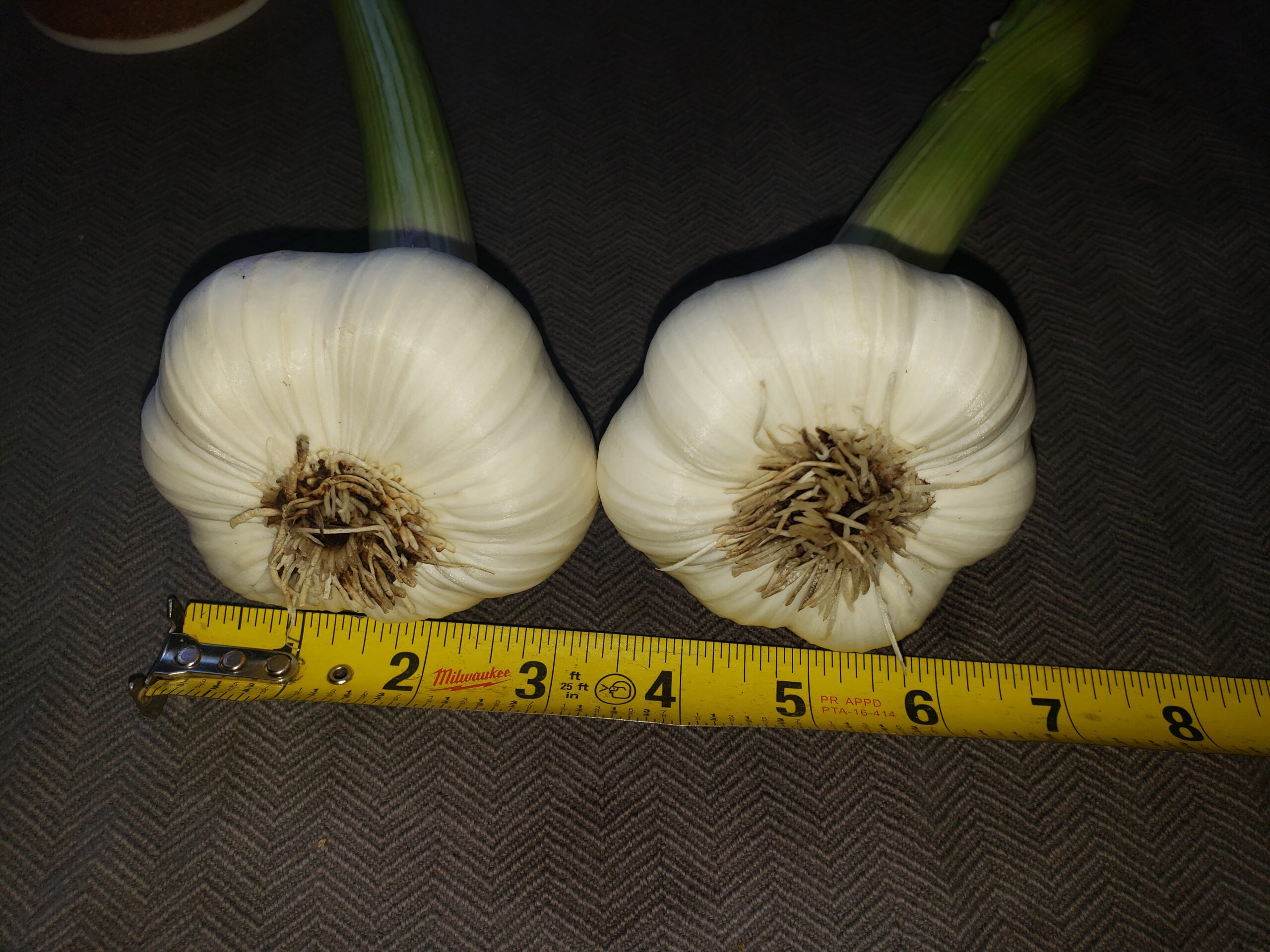
Choosing the Right Garlic Seed Size
Learning how to grow garlic starts with selecting the best organic seeds, and size plays a crucial role in this process. At Basaltic Garlic Farm, we’ve observed that larger seeds often lead to larger bulbs, guiding our approach to produce and provide giant seeds for our customers. We categorize our garlic sizes as follows:
It’s been said size matters when selecting garlic seeds for planting. The bigger, the better.
We found this to be true. You will get different bulb sizes if you plant every seed in a bulb. Basaltic Garlic Farm tries its best to produce giant seeds so we can pass them on to you. We think it is a good idea to standardize bulb size. We sort our garlic size by inches,
- Large/Jumbo 3 inches and up
- Medium/Culinary 2 to 3 inches
- Small 1 to 2 inches
- Baby Garlic size is less than 1 inch
All Garlic has different seed sizes in every bulb. Since we are a small farm, we put about 10 acres in production per year. Our large bulbs sell fast and go out on a first-come, first-serve basis.
Interestingly enough, smaller-sized seeds usually increase in size year after year. Proper care is the key, meaning you can grow most anything with decent soil, adequate water, fertilization, and sunlight. We are blessed with fantastic, well-draining, sandy volcanic loam soil, which is the foundation of plant health.
When To Plant Garlic
Regenerative Organic Farming
In the USA, fall is the best time for planting garlic.
Learning how to grow garlic organically is not as complicated as you think! Accepted planting times for most types of Garlic are about 4 to 6 weeks before the ground freezes. In the Northern States, the recommended time to plant is mid-October. The southern States can plant well into December.
Suppose you encounter an early freeze; no worries. Garlic is a very hardy plant. Garlic loves freezing ground or vernalization, which creates solid roots and larger bulb sizes. If you are planting late, dig the hole at least 6 inches deep and cover it with mulch. The mulch can be compost soil or seed-free straw. Be sure to water right after planting so the soil voids are removed.
There has been much discussion about planting early. Some say it can waste seed energy, sending sprouts up. Others are finding planting early is beneficial to solid root development. However, we found that planting early helps increase bulb size. Even though most sprouts die back at the tips in freezing weather, the roots become more vigorous and create better growth in the spring. Basaltic Farm’s elevation is 3100 feet we regularly receive 18 inches of snow during the winter months.
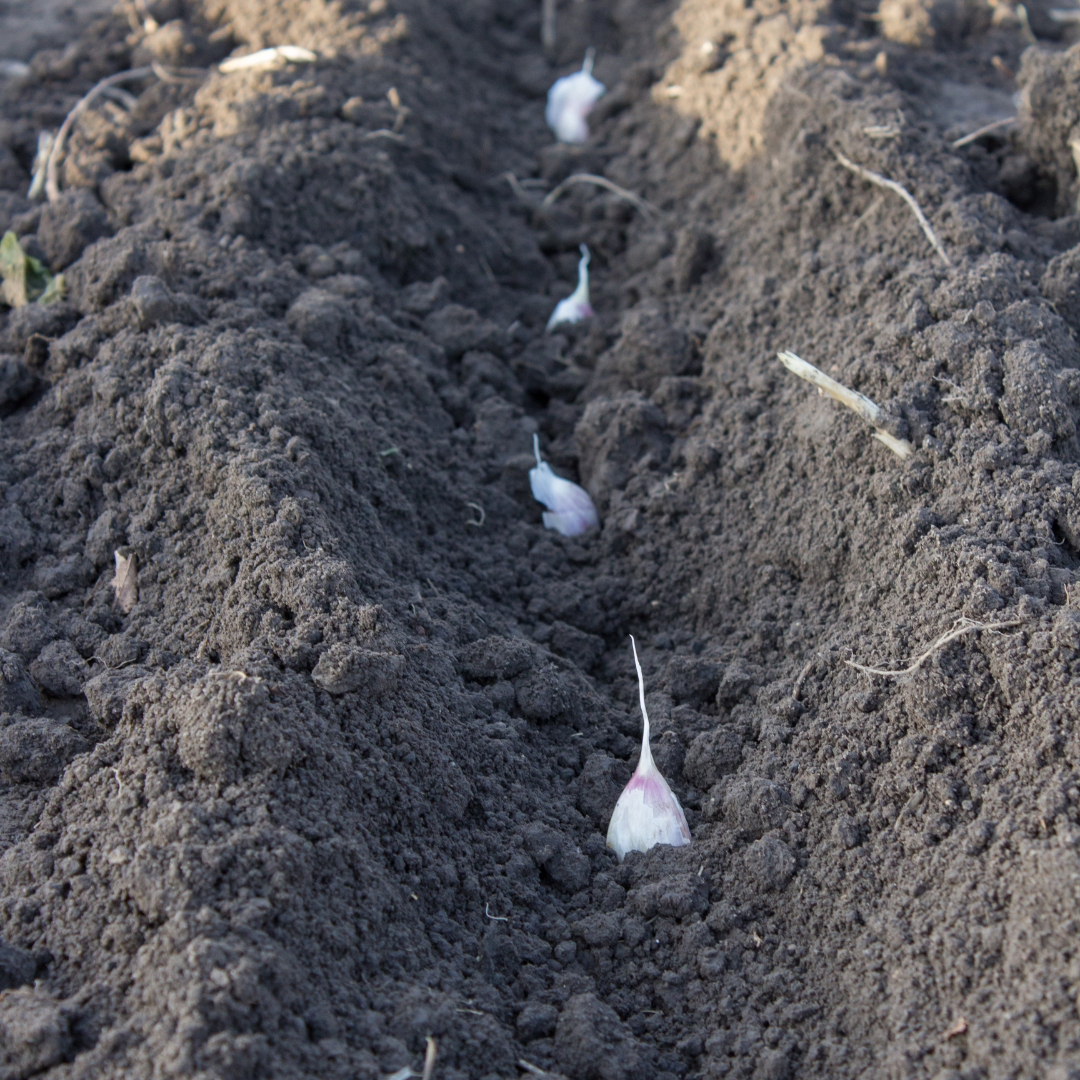
Is Planting Early Worth It?
Understanding how to grow garlic in your local environment is key. There has been much discussion about planting early. Some say it can waste seed energy, sending sprouts up. Others are finding planting early is beneficial to solid root development. However, we found that planting early helps increase bulb size.
Even though most sprouts die back at the tips in freezing weather, the roots become more vigorous, creating better spring growth. Basaltic Farm’s elevation is 3100 feet. We regularly receive 18 inches of snow during the winter months.
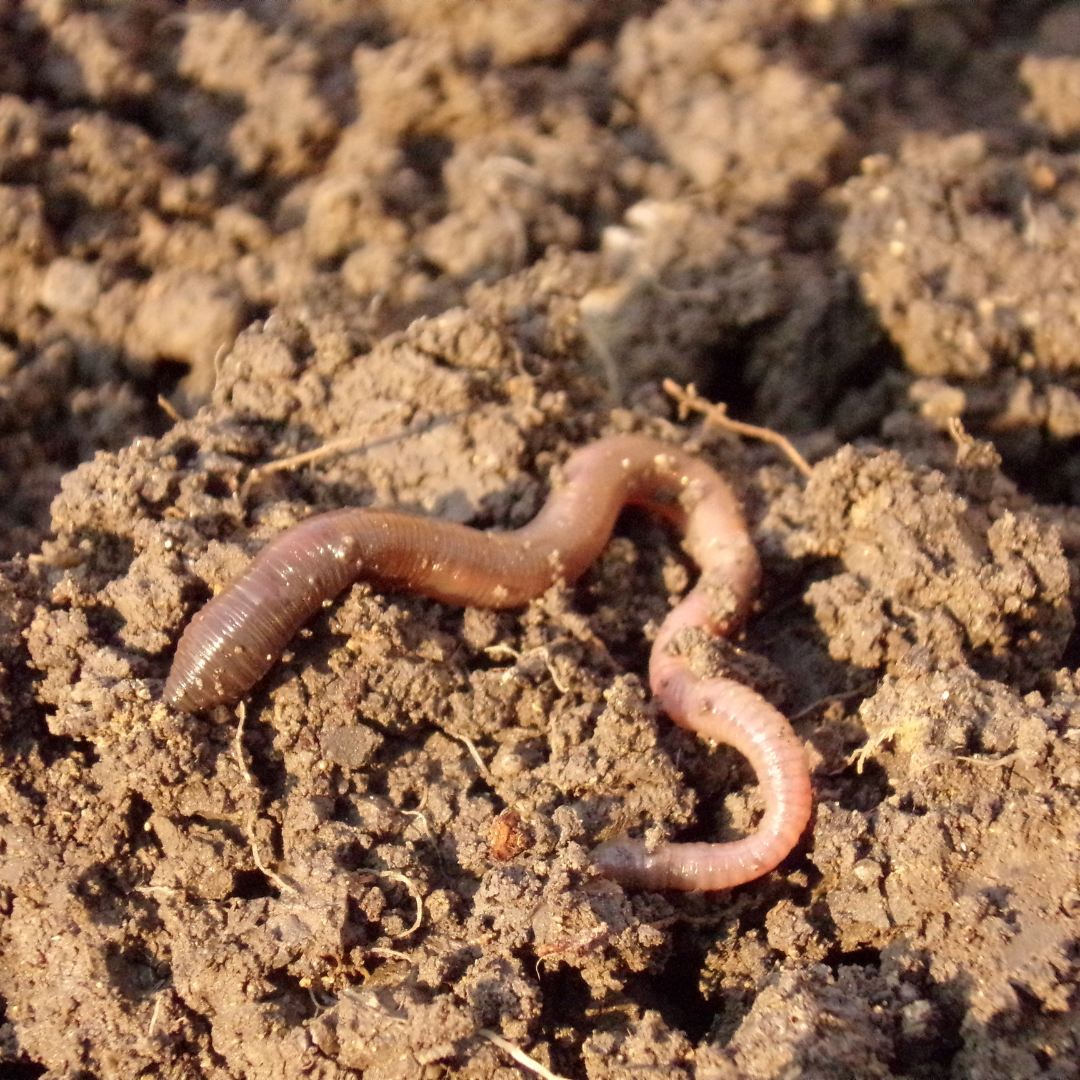
Planting, Planning & Preparation
Soil Health Tips
Planning is critical if you’re serious about gardening. Preparing your ground is necessary for the best yields. In the spring, get your soil report, and select the right cover crops to unlock your soil. Buckwheat sprouts at 60 degrees and adds phosphorus. Mustard bio-fumigates and helps insect control. Legumes add nitrogen. See our cover crops page for more details. If you need amendments, please select OMRI-approved only. You’re purchasing certified organic seeds, so don’t spoil them with non-approved amendments.
Since Garlic is a heavy feeder, it needs nitrogen, potassium, phosphorus, and sulfur and a PH of 6.5 is optimum. Get these into the ground before planting for the best results. We also recommend foliar feeding in the spring with Neptune’s Harvest seaweed and fish emulsion. Stop feeding and watering three weeks before the intended harvest. In the last three weeks, a little stress increased bulb size and tightened the protective paper around the bulbs.
After harvest, get an updated soil test and plant appropriate new cover crops. Building healthy soils is a never-ending process. Cover crops, also known as green manure, continue to add back what was taken from the ground and significantly contribute to organic matter critical to soil health. Soil tests help you better understand micro and macronutrient dynamics. It can get complicated, but the right cover crops naturally do all the hard work for you.
Do Cover Crops Help?
After harvest, get an updated soil test and plant appropriate new cover crops. Building healthy soils is a never-ending process. Cover crops, also known as green manure, continue to add back what was taken from the ground and significantly contribute to organic matter critical to soil health. Soil tests help you better understand micro and macronutrient dynamics. It can get complicated, but the right cover crops naturally do all the hard work for you.

Lab Test Your Soil For The Best Garlic
Our goal is to completely understand how to grow garlic organically and pass on the information we learn. We work with soil scientists from laboratories and get regular soil tests. The laboratory said that if the soil is balanced, the plants can uptake the natural minerals usually locked out in abused soils. We did a lot of research on cover crops and found that certain types of plants unlock minerals found in every soil type and can also help choke out our beloved weed problems.
The weeds steal nutrients from everything, which affects bulb size. Gardening is work, but the rewards are well worth the effort.
We use Ward Laboratories, and you can mail them a soil sample. There are many types of tests offered. Please read the site, order a test, and get a free consultation with Dr. Ward or his son, Nick.
Basic tests are around $16.00, which is well worth the investment. If you ask, they will also recommend what cover crops are best for your soil. We believe in regenerative sustainable agriculture practices; the more ground is reclaimed, the better.
Soil Preperation Tips
Rule of thumb: You will get large bulbs if you plant large jumbo seeds. Our Music garlic is mostly Jumbo, but Sicilian and Inchelium produce Jumbo/ Large bulbs.
We also have a few garlic experts to help you with any garlic questions. Just give us a call.
Garlic Fertilization Soak
Pros & Cons of Garlic Fertilization Soak
Pros: A proper soak will stimulate early root growth if you have a small amount of garlic to plant. Sterilization can help knock down natural molds found in all soil types. Well-known seed sterilizers are vodka, isopropyl alcohol, and hydrogen peroxide. OMRI products such as Cinnerate are fast-acting knockdown miticide & fungicide that goes to work immediately to stop disease, immobilize and kill mites and other insects.
A few tablespoons in a five-gallon bucket soaked for one to two hours will ensure your seeds are sterile. If you are going to soak your seeds, you should also have fertilizer soak too. Use suitable quality fish emulsions such as Neptune’s Harvest, a well-known OMRI-approved fertilizer for all growing plants. If you are going to soak your garlic, try using a netted bag; it really helps, making it easy to collect all the garlic at once.
Cons: If you are trying to keep your organic seed pure, finding ORMI-approved products can be difficult. It is a lot of work to keep track of what to do.
For example, planting a large area of soaked garlic will clog up your planting equipment. However, if the weather becomes a problem, such as unexpected rain, and you can not plant, you may end up with root growth in as little as 48 hours on soaked seeds.
However, the garlic may be damaged, stunted, or die if you damage those new roots. Therefore, you must use great care not to harm any new growth if you see it.

Mistakes to Avoid When Planting Garlic
On the subject of straw vs. hay, hay is material from an herbaceous plant allowed to go to seed, and straw is cut before the seed is formed—this lesson we had to learn the hard way.
For our purposes, seeded hay is undoubtedly undesired in our field since it introduces a plethora of seeds from plants we don’t necessarily want growing in abundance.
It also overtook the garlic crop, started choking out the sunlight, and formed a dense mat of weeds stealing the nutrients we added. It was extremely time-consuming to spread the seeded hay. So we spent weeks on our hands and knees pulling the weeds. So never use seeded hay on any crop you plant for mulching.
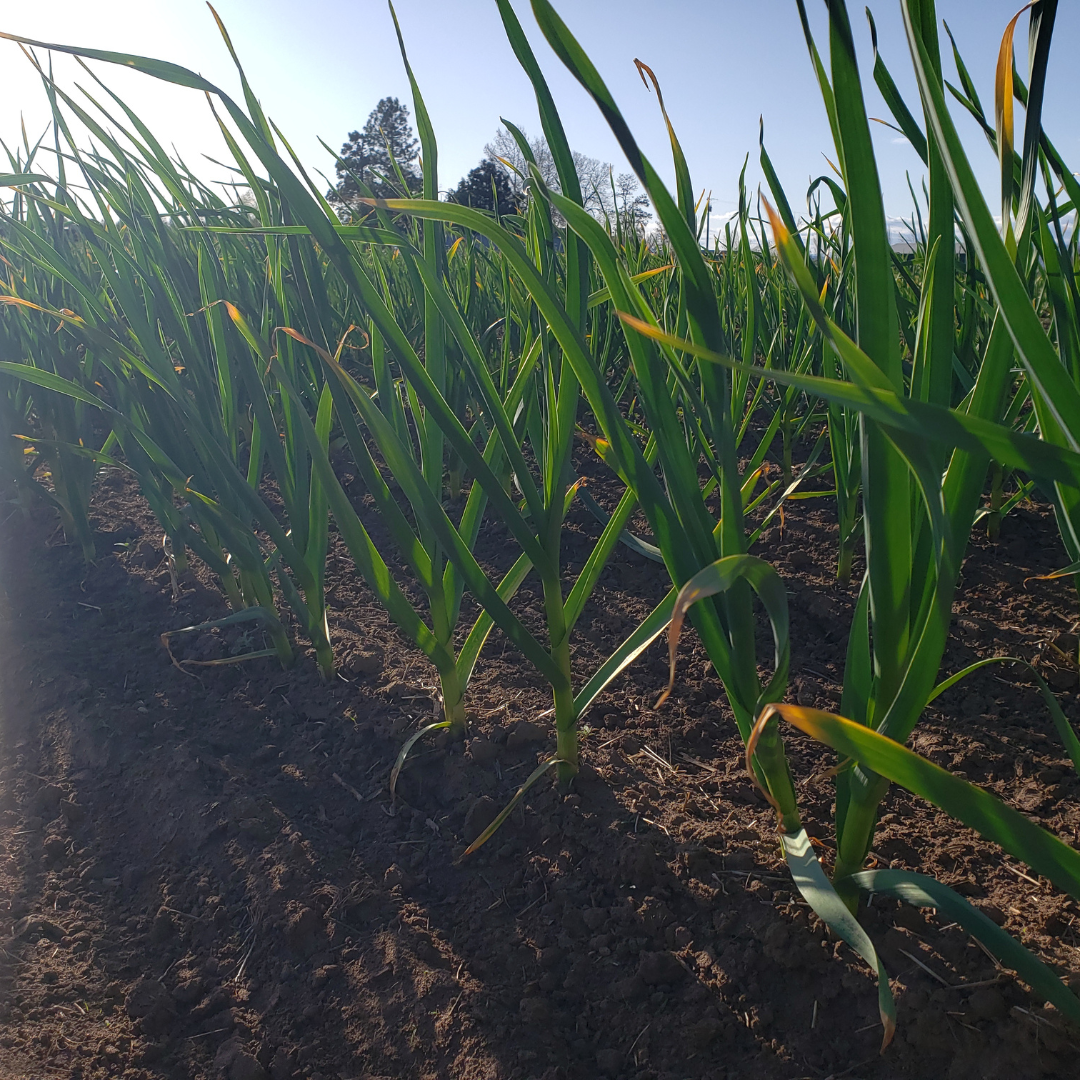
More on the subject of straw vs. hay
We first spread seeded hay that we received from a neighbor for free, thinking, “Hey, it’s free hay. What could go wrong?” So we decided to stop until we could get unseeded straw about a week into spreading because there was way too much seed in the hay to justify using. A couple of us had a feeling that in a few months, we’d be pulling up a lot of grass from those areas. Well, we were right.
We mostly spent the month of March pulling up grass that had seeded from the hay and spreading new straw over the whole crop. Luckily, we have neighbors who cut, store, and sell straw and fodder for about half the valley; they hooked us up with a great deal on tons of rice straw! With 64 bales in one ton, we should be able to get more than enough to cover the garlic plants!
Straw Spreading Antics
We got a break from pulling grass up from the field as a snowstorm hit and allowed for some playing time. We stayed warm by the fireplace! Mid-march, the decent-sized winter storm filled our little valley with about 1 1/2 feet of snow. This put our straw-spreading antics on hold until the field dried out later in the month. Last winter, we learned that driving on a wet field will likely get your equipment stuck!
Second Season of mulching ideas
This season we bought a straw blower which we thought would save us time applying the mulching cover. Well, it did the job and cut the unseeded straw into small pieces. It took four people to operate and one person to feed the straw into the blower. Poor guy was running back and forth with 120 bales and setting the bales up onto the tractor. So the next guy had to split open the bale and feed it into the hopper. If you provide the straw too fast, it comes out in clumps. Creating uneven application hence requires someone to go out and redistribute the straw. One person on the 40-foot hose to apply the straw. One person on the tractor used forks to move the beast from place to place. Alfalfa is crushed easily and comes out like powder making it easy to apply.
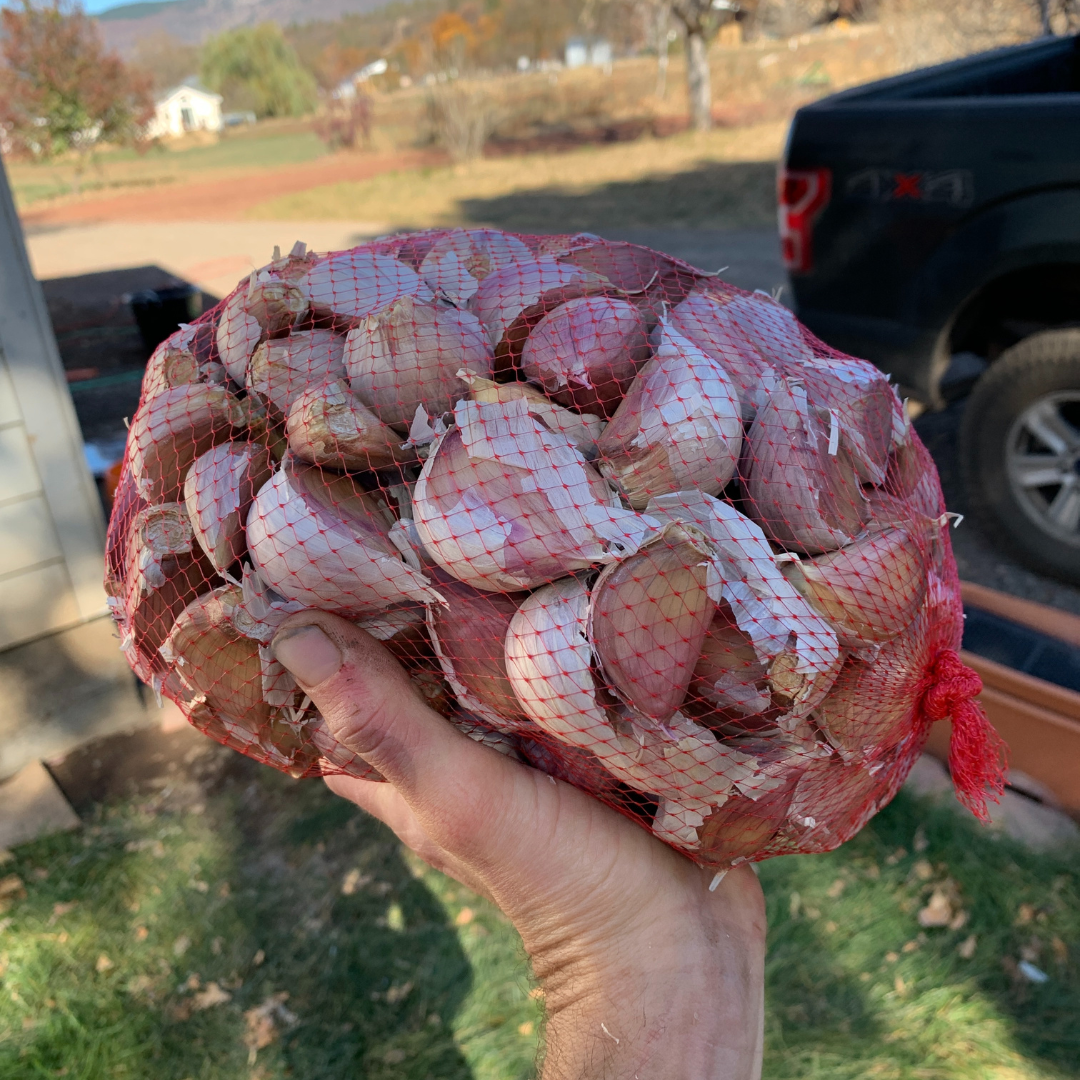
Fall Garlic Planting
Composting Tips
The garlic journey starts when your seed is planted four to six inches deep and twelve-inch wide rows in the ground. Be sure to water immediately after planting to remove air voids in the soil. We also recommend a light dressing of mulch or straw around two to four inches. Depending on your location, you can plant up to the end of December. Garlic takes nine months to reach maturity.
We love the winter months as there is little to do while the garlic roots take hold and grow unseen to your eyes. As our ground starts to freeze, the vernalization process begins. Garlic roots begin to grow deeper into the soil slowly. It is too cold for weed seeds to germinate, so work is suspended until it warms up. All soils have weed seeds and are brought to your location by winds and birds. We are glad we get to take a break from weed control in winter.
Soil Preperation Tips
Keeping weed pressure to a minimum is important, as the weeds will eat up the soil amendments you added. So removing them as quickly as possible is a good idea. Little weeds are much easier to remove than big ones.
Garlic loves moist well, draining soil, and should receive one inch of water weekly. If you have natural rains, this eliminates the water need. If you receive large amounts of rain, the garlic will not mind. But it will not like standing water for more than a few days, so avoid planting in areas prone to flooding. If you lack enough rain, then you must water. The trick to pungent garlic is deep roots in good soil.
Garlic roots, under ideal conditions, can reach twenty-four inches in depth. The deep roots help the garlic regulate extremes such as summer heat or forgetting to water. So water as required; use a rain gauge to help keep track.
Spring Garlic Planting Tips
Regenerative Organic Farming
Our experiments have shown it is not a good idea in the USA as it results in smaller bulbs, just a single bulb, or a single solo stalk, which is not really a bulb. Garlic needs vernalization to split into many seeds. If your goal is fresh-tasting garlic shoots for salads, then spring planting will work.
You can delay harvest but the formed bulbs will be smaller. You can also let them die in the ground and overwinter until the next season. The result will be a new plant for each seed from the leftover bulb, which again will be ill-formed bulbs due to overcrowding.People have tried to trick the garlic seeds by placing the bulb in a refrigerator for 40 to 50 days.
Unfortunately, there are no conclusive peer-reviewed studies on this planting method yet. I thought you might find big box stores selling garlic seeds in the spring. You can be sure it’s from other countries, and the bulbs are not acclimated to the USA, which means poor results.
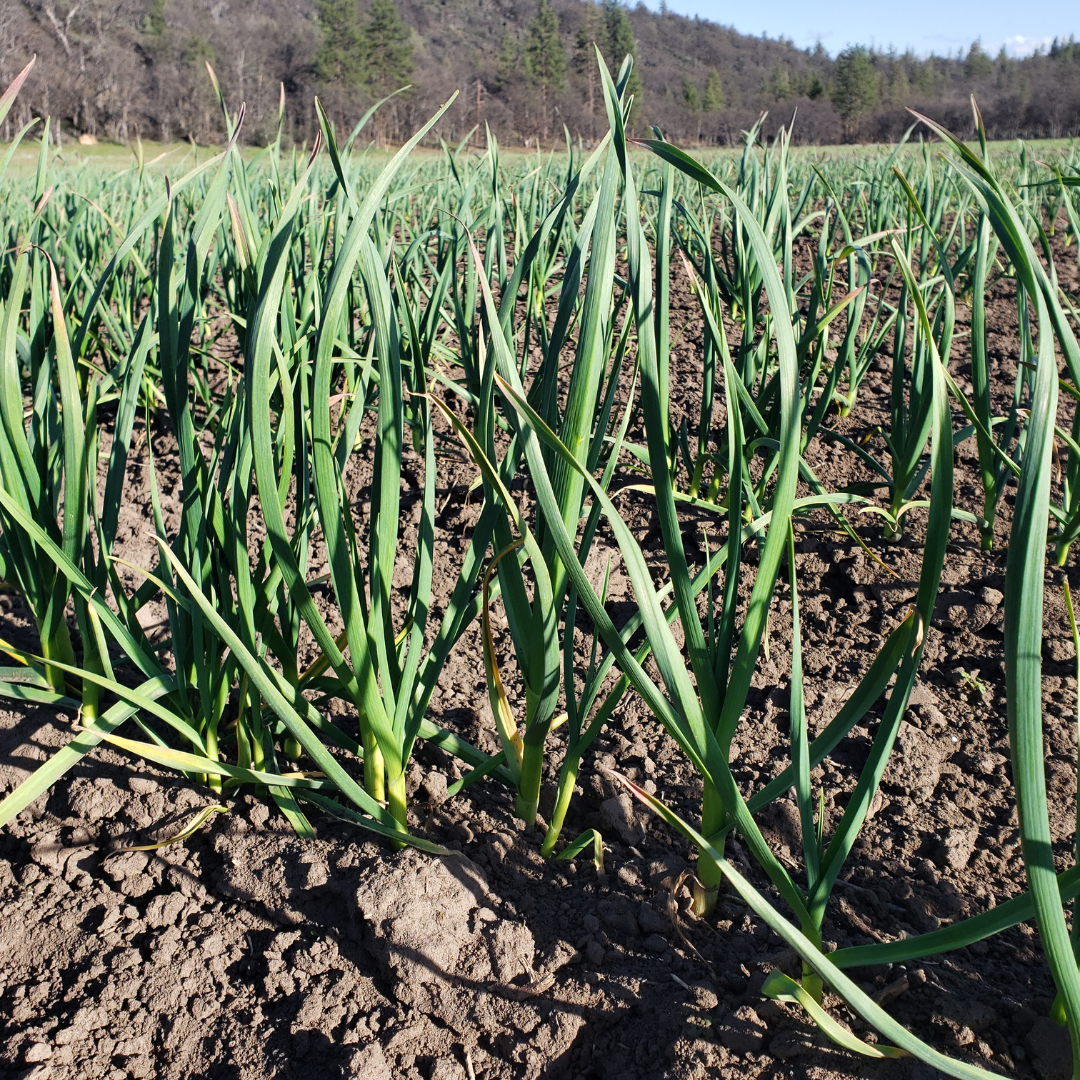
Soil Preperation Tips
Keeping weed pressure to a minimum is important, as the weeds will eat up the soil amendments you added. So removing them as quickly as possible is a good idea. Little weeds are much easier to remove than big ones.
Garlic loves moist well, draining soil, and should receive one inch of water weekly. If you have natural rains, this eliminates the water need. If you receive large amounts of rain, the garlic will not mind. But it will not like standing water for more than a few days, so avoid planting in areas prone to flooding. If you lack enough rain, then you must water. The trick to pungent garlic is deep roots in good soil.
Garlic roots, under ideal conditions, can reach twenty-four inches in depth. The deep roots help the garlic regulate extremes such as summer heat or forgetting to water. So water as required; use a rain gauge to help keep track.

Planting Garlic in Frozen Ground
It can be challenging depending on the depth of the frozen soil; if the ground is frozen more than 6 inches best to wait until next year, as it will be a lot of work for you.
For example, suppose you are planting on a small scale, like a raised bed or pots; you can pull off an excellent crop without much effort.
- Be sure to plant the seeds at least 6 inches deep and water the seeds well to prevent soil voids.
- Soaking the garlic seed will help in fast root development.
- Be sure to mulch 2 to 3 inches to protect the seeds.
- Remember, Garlic likes well-draining soil and 1 inch of water per week.
We heard of a farmer whose lower field flooded in the spring, and all his hand-planted Garlic floated away due to late planting. The roots did not have time to anchor the seeds. Heaving soil can also cause bulbs to be expelled out of the ground. If Garlic is vital to you, plan and do it right the first time.
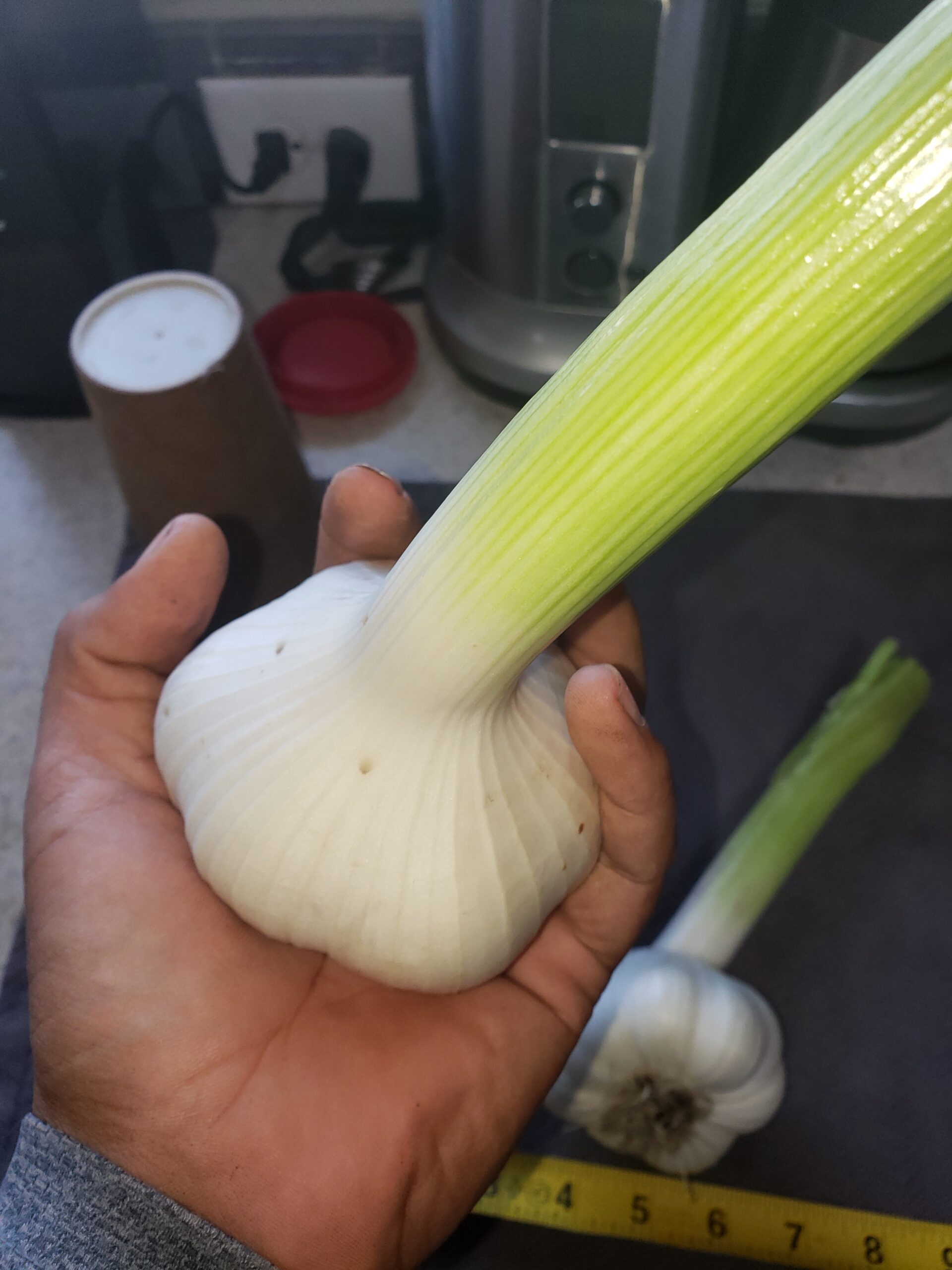
Harvesting Garlic Best Practices
In the United States, the usual time for garlic harvesting is late June to mid-July. Each latitude with vary by two weeks, more or less. Therefore, it is essential to keep a close watch at this time.
When the hardnecks finish scaping, you have about 3 to 6 weeks before maturity. Garlic is a nine-month crop.
Did you Know? As garlic matures, bulb size increases dramatically during the last six weeks of growth. It tells the plant I am near maturity and I better hurry up and protect my seeds. If a hardneck detects Oh, my flower has been cut. I am in an emergency; I need to protect myself. My only option is to increase my seed size. I have no flower seeds to produce. Somebody decided to eat my beautiful curly scape, though it was a tasty idea. OK, I am into no waste.
TIP: Stop watering two weeks before you harvest. This lack of water helps the natural papers tighten around the bulb and seed/clove. If you overwater, you increase the chance that the bulb will split at the top, which decreases the shelf life. If a softneck detects Oh, I am drying out, I better get more water from my 30-inch deep root system and give my energy to my seeds. It’s the only way I can reproduce. All garlic reacts the same way; a bit of stress the last two weeks works wonders when the goal is to get maximum bulb size. This also enhances the flavors by concentrating alliums, one of the most beneficial chemicals garlic produces.
What to look for: Yellowing leaves appear halfway up the plant. The bottom leaves are brown and drying up even though you are still watering. Many people count the leaves; the garlic is ready to harvest when the top has five green leaves and the rest yellow. We like to dig around the top of the bulb and inspect its size. We put a flag in the field where we test.
The leaves on all garlic plants become the protective papers surrounding the bulb. The leaves reach down to each seed. It’s garlic’s natural way to protect the seed or clove.
To Get The Best Results: You should end up with 4 to 5 papers around the bulb when you harvest. If you are harvesting by hand, use the least amount of force to get the bulb out. If you pull it too hard, you can lose several layers of paper. This results in shorter storage times. Do not be overly concerned if the garlic has dirt on it.
Any large clods clinging to the roots should be removed. The more papers, the better for more extended storage. It’s better to have more paper and some dirt on the bulb than remove the papers to make it look pretty. After all, it’s what is inside that matters. Nothing is better than grabbing a nice juicy garlic clove for your favorite recipe from garlic you have grown.
If you see the top, the garlic starts to split open at the top; you have waited too long. No worries if it is just a little bit and 1/8 of an inch. But do not delay any longer and get that garlic out of the ground. The seeds/cloves are still usable.
But if you have been watering or received rain or forgot to stop, mold can quickly become an unwanted issue if your garlic starts to split open. Timing is everything when it comes to harvesting healthy long storing garlic bulbs.
Signs that garlic is ready to harvest:
- Five or six green leaves remain on the top of the garlic plant.
- Fifty percent of the plant has yellowed and died back.
- Hardneck flower or scapes lose their curl and point straight up.
- Harvest garlic about 3-5 weeks after removing the garlic flower known as scapes.
